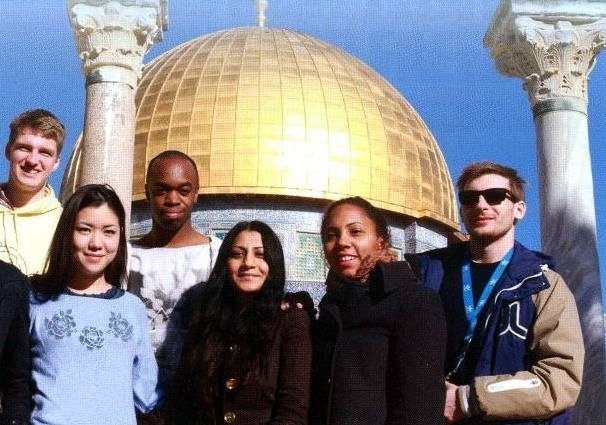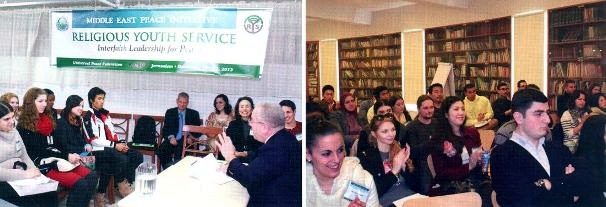![]()
The Words of the Ben-Zvi Family
|
|
The Words of the Ben-Zvi Family |

Toward the end of 2013, the international Religious Youth Service (RYS) conducted a project in Jerusalem. Taking part in this program were forty-two participants from fifteen nations. These young high-spirited leaders came to the Holy Land to learn about the complicated geopolitical reality here, and to try to understand better the hearts of the locals, Israelis and Palestinians. Being together, the participants had an opportunity to get to know one another and to experience one another's different religious and cultural background.
From its outset, the program had three pillars: interfaith exploration, leadership and service. Despite the short time allocated to each aspect, we tried to weave them in the overall experience. On the first day, we went to the Old City, to experience closely the three Abrahamic faith traditions, Judaism, Christianity and Islam, by exploring their holy sites. First, we visited the Temple Mount, with its magnificent Dome of the Rock, which is one of the three holiest places for Muslims, the other two being the Mosque of the Ka'ba in Mecca and the Mosque of the Prophet Muhammad in Medina. We were able to hear about the Prophet Muhammad, who ascended to heaven from Temple Mount. Muslim are not unanimous in their view of the ascension -- some think it occurred physically while others believe it was a purely mystical experience. In either case, it occurred before the end of the Prophet Muhammad's earthly life.
In the seventh century, Muslims conquered Jerusalem. Fifty years after the Prophet Muhammad's death, Caliph Abd al-Malik ibn Marwan ordered a temple built on the Dome of the Rock site. As one recent Islamic visitor to the site observed, "The Dome of the Rock is like Jerusalem's own sun, a gleaming, powerful presence that tells the world that Islam is here to stay -- which was its builder's purpose."

Left:
Dr. Frank LaGrotteria greets the RYS participants; (By the wall, from
left): Hod Ben Zvi, UPF-Israel; Liel Shmueli, Tomiko Duggan and
Koriel Ben Zvi; Right: Participants respond to a panel discussion
Next, we went through the Via Delarosa, literally, "the suffering path," the course that Jesus is thought to have taken on the way to his crucifixion. Since soon after Emperor Constantine formally recognized Christianity as a legal religion, pilgrims have come to Jerusalem to gain some vicarious understanding of what Jesus endured in his last hours on earth by walking where it is thought Jesus walked. In the earliest times, pilgrims walked without stopping but today those who follow the course stop at what represent significant moments in Jesus' course toward execution, crucifixion. The actual course believers follow has changed periodically, the emphasis being on the emotional experience rather than on historical veracity. In the Middle Ages, when the Roman Empire had split into eastern and western empires, Christianity developed differently in the east and in the west. The Pope led Christianity in the Western Roman Empire. A Patriarch led the church in the Eastern Roman Empire. When experiencing the Via Delarosa, believers whose churches were in the west went generally west; believers whose churches were in the east followed an eastern trajectory. In Christian churches today, you may have encountered a series of bas-relief plaques depicting "stations of the cross." These depict the stops along the Via Delarosa course, which extends about five hundred meters. At the time that the concept of Stations of the Cross was developing in Europe, the Via Delarosa had eight stops. This was increased to fourteen to coincide with the European Christians' efforts to help the faithful to deeply sense the emotional aspects of Jesus' final hours. Next, we headed towards the Jewish quarter and met with Rabbi Reuben. This inspiring Rabbi showed us the unique way that Jews practice their belief in God. They truly believe it is through studying the word of God.
On the second day, we held two special panels at Hebrew University. Among the panelists was Ephraim Meir, who once headed the Department of Philosophy at Bar-Il University. The author of numerous books in Dutch and in Hebrew, Professor Meir was born in Belgium and immigrated to Israel in 1983. Haim Koen is a professional diplomat. He has been the director of the Political Planning Division at the Ministry of Foreign Affairs, deputy director of the Religious and Sects Department and was an instructor at the National Security College. He was appointed ambassador to Egypt in late October 2013. Kobi Nehushtan is a practitioner of homeopathic medicine and a student of Kabbalah, a mystical aspect of Judaism. Naomi Tsur is the deputy mayor of Jerusalem. Before being elected to the Jerusalem City Council, from which post she was appointed deputy mayor, she was a leader of the environmental movement in Israel. She headed SPNI, the Society for the Protection of Nature in Israel. Dr. Nurit Hirschfeld is a doctor of rabbinic literature and head of UPF-Israel's Jerusalem Forum for Interfaith and Cooperation among Religions and Adi Sasaki, is director of UPF-Israel's Jerusalem Office for Peace and Security. The expert panelists discussed the geopolitical situation in the Middle East and the importance of having interfaith dialogue and corporation. The participants were enthusiastic and wanted to learn and absorb the information. They asked the panelists important and challenging questions.
After the sessions, we went together to see the beautiful view of the Old City from one of the mountains surrounding it. In the evening, we experienced together the Jewish Sabbath. To welcome the Sabbath, we went to pray at a famous reform synagogue. Even though the whole prayer was held in Hebrew, the atmosphere was very nice and inviting.

Left:
Participants learn about Judaism as part of the interfaith education
that is integral to the RYS experience; Right: A couple, offers a
prayer during the peace march.
The next day (Saturday), we went to an Arab village named Isawie, which is located on the east side of Jerusalem. There we did a service project at an important school which provides special education for children with disabilities of various types. The manager and some staff members welcomed us warmly and gave us a tour of the place. We were surprised to see all the different and creative ways the school was using to help the children. After the tour, we divided ourselves into small groups and went to spend some time with the children. The interaction with the kids was amazing; through the experience we could learn to accept other people regardless of background or the differences.
The other part of the day was held in Al-Quds University, in Beit Hanina, which is an Arab town near Jerusalem. In this university, we attended a panel discussion that dealt with the topic, "democratic values in Middle East tribal society." A woman lawyer gave us her perspective on Palestine as an independent country; also, Dr. Mantsur gave us an introduction of the history in the Middle East. Later, we met Arab students and had a session of questions and answers with them about their views and feelings on the Arab -- Israeli conflict.
In the evening, we participated in a special celebration -- the tenth anniversary of the Middle East Peace Initiative. The event took place at a famous hotel, and the group met many important ambassadors for peace from all over the world. The young members mixed in with all of them and were excited to talk to them. Later in the event's program, our group was called up to stage, to share our vision and thoughts. The adults were very happy and inspired to hear the young and courageous members.

Left:
RYS members enter a school, in East Jerusalem, for children with
various handicaps; Right: At the Dome of the Rock
On the final day (Sunday), we went to the Old City and took part in the famous peace march, which is a customary part of UPF's MEPI program. The march touched some participants. Next, we went to the famous Holocaust Museum of Israel. After the tour, we had some time to ask our tour guide questions about the holocaust.
After lunch, we went back to our hotel, where we had a chance to hear from a former soldier in the Israeli Defense Forces who took part in one of the latest wars in south Israel. She shared about the difficulties of commanding other soldiers during that time even though her parents had raised her with values that stressed the pursuit of peace. In the evening we had a concluding ceremony at which all the participants received the RYS graduate certificate.
J. B. G.
"I have made some long lasting friendships and am glad to have spent time with RYS and the Youth UPF that made me feel very welcome and accepted even though I don't belong to any faith in particular. MEPI is doing great work and learning about the work they do was inspirational. This has left a warm feeling of support and hope for world peace in the future. "
A. C.
"I am so very grateful for having been a part of this blessed journey, I still feel like this is all a dream, a beautiful dream. The complete schedule was diverse, incorporating a vast array of activities, all very apt and relevant to the reason why we were on this trip. We achieved so very much in a matter of 4 days and it feels quite unreal that we accomplished so much in such little time with such amazing results and outcomes. This trip, this journey of both the outward and inward journey has left me feeling grateful, appreciative of what I have, hopeful for what is to come, and confident that I can make a difference in the lives of others.
"I was told various things from the participants, and each time I was spoken to, I felt the presence of God through their words, I felt that my being on this journey in Jerusalem is not a coincidence, but intentionally planned by God. The beauty within every participant was both unique and special, and God answered every question, every hope, every desire I went with, through the spirit of the participants....
"Seeing Jerusalem for what it is now, and for what we all hope it shall emerge as has taught me to be strong, courageous, faithful and positive....
"Viewing the struggles, the sadness and the upset amongst the faces of those that live in this county, has allowed me to have hope and to acknowledge and be grateful for all that I have, but to also strive to help alleviate the challenges the Israelis and Palestinians encounter....
"I have returned from Jerusalem with a greater desire to be of assistance to others, and the belief that I can make a positive difference in the world. This journey has been both rewarding, beautiful, inspiring and unforgettable. The memories are priceless and shall be cherished forever."